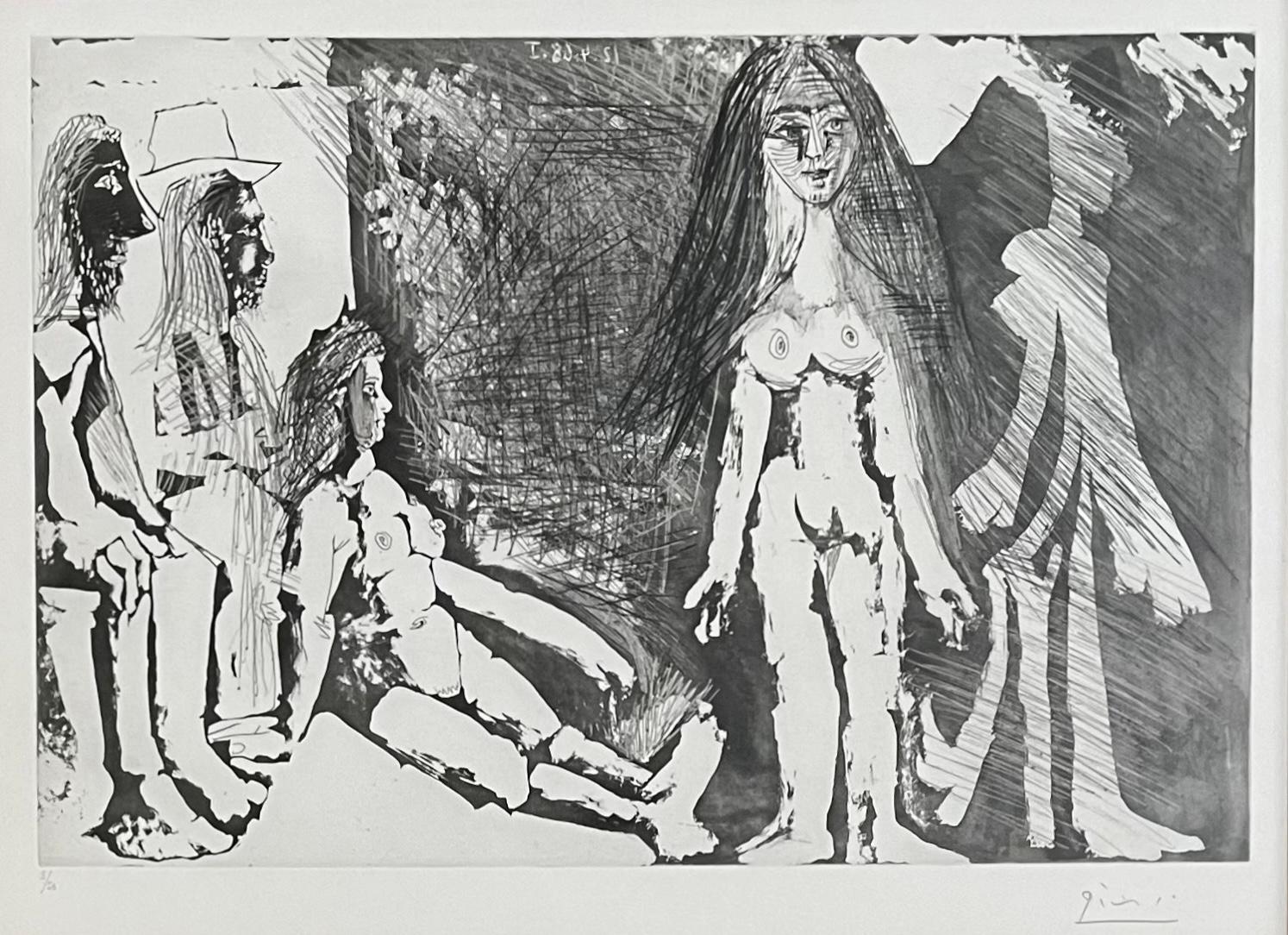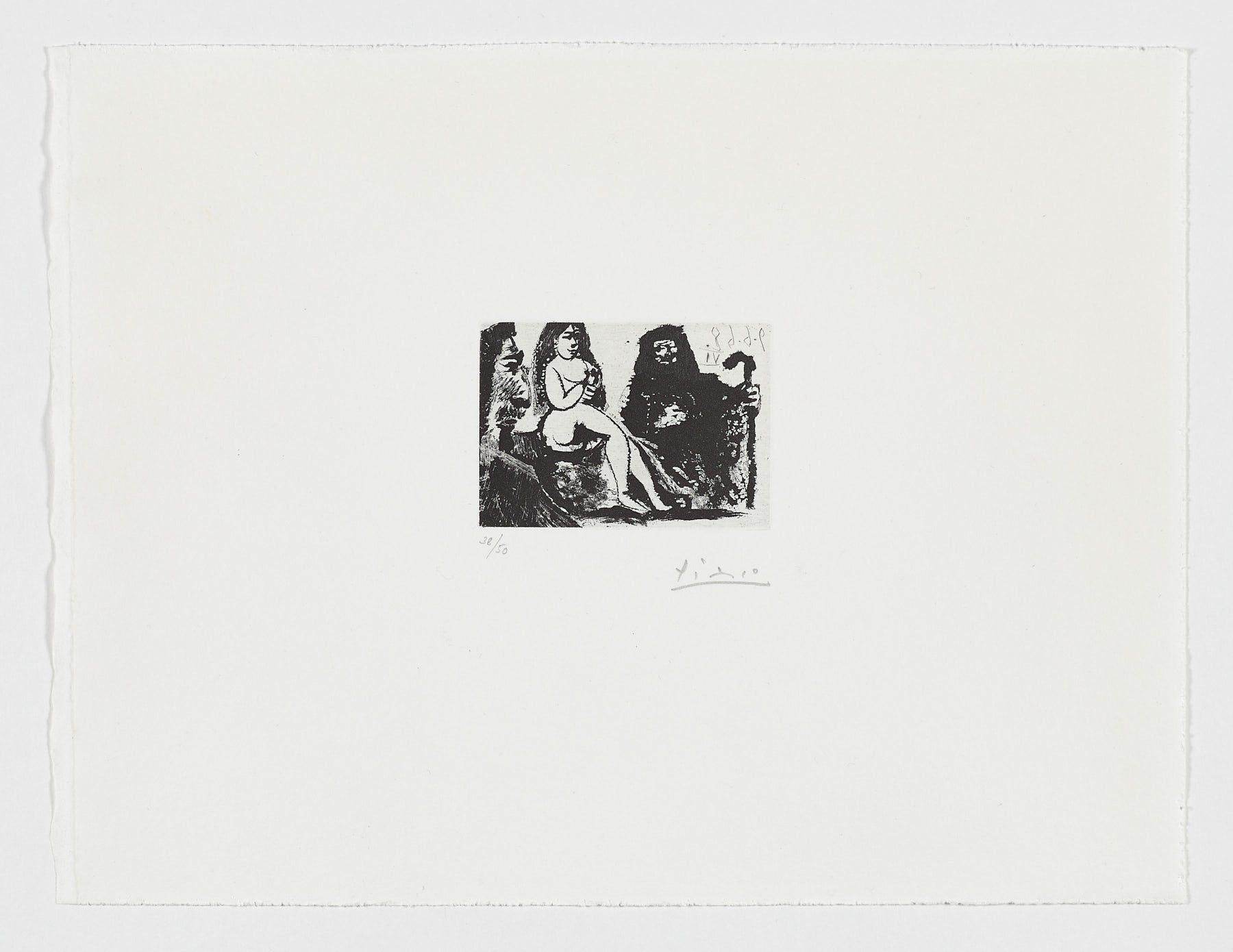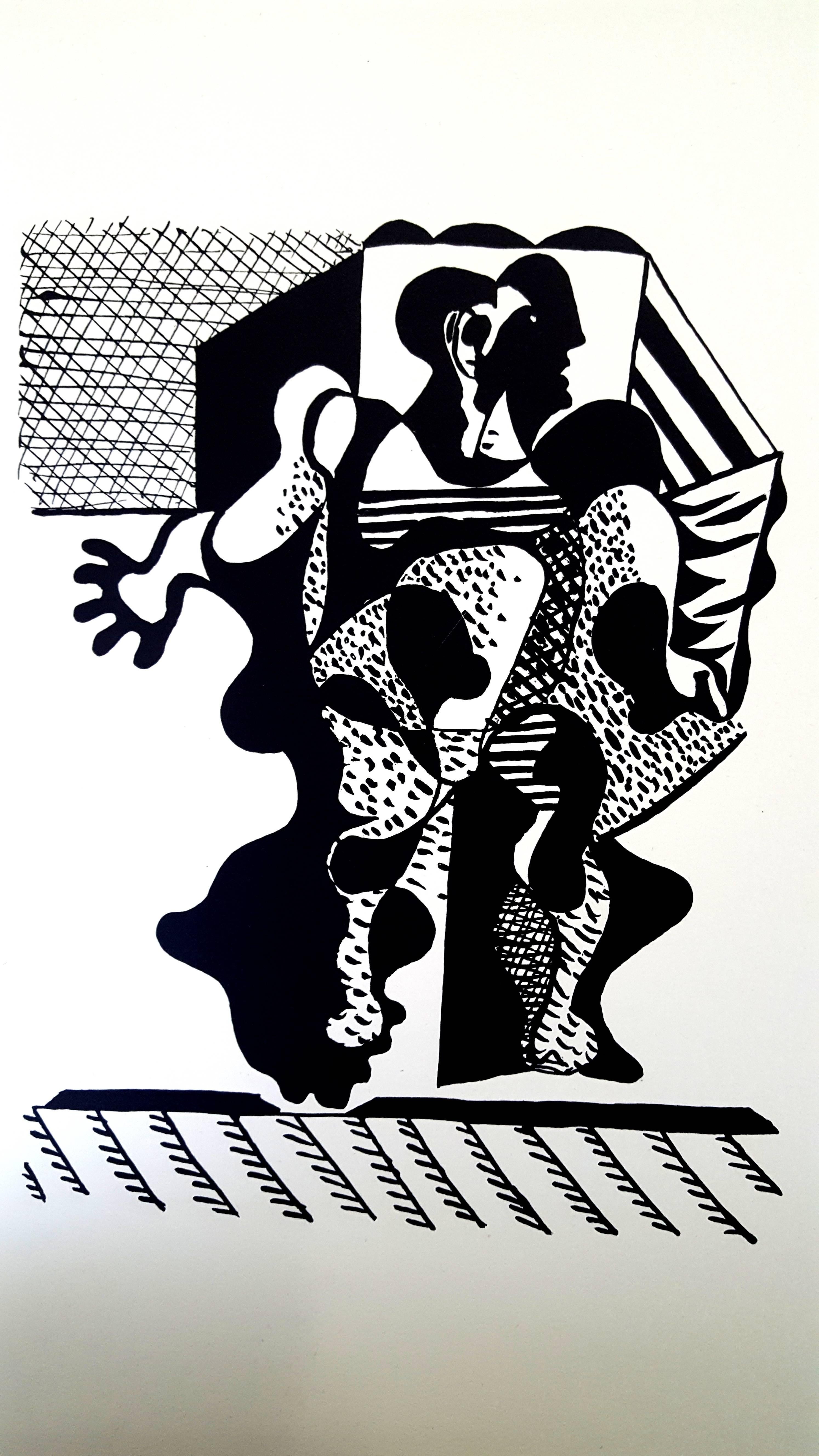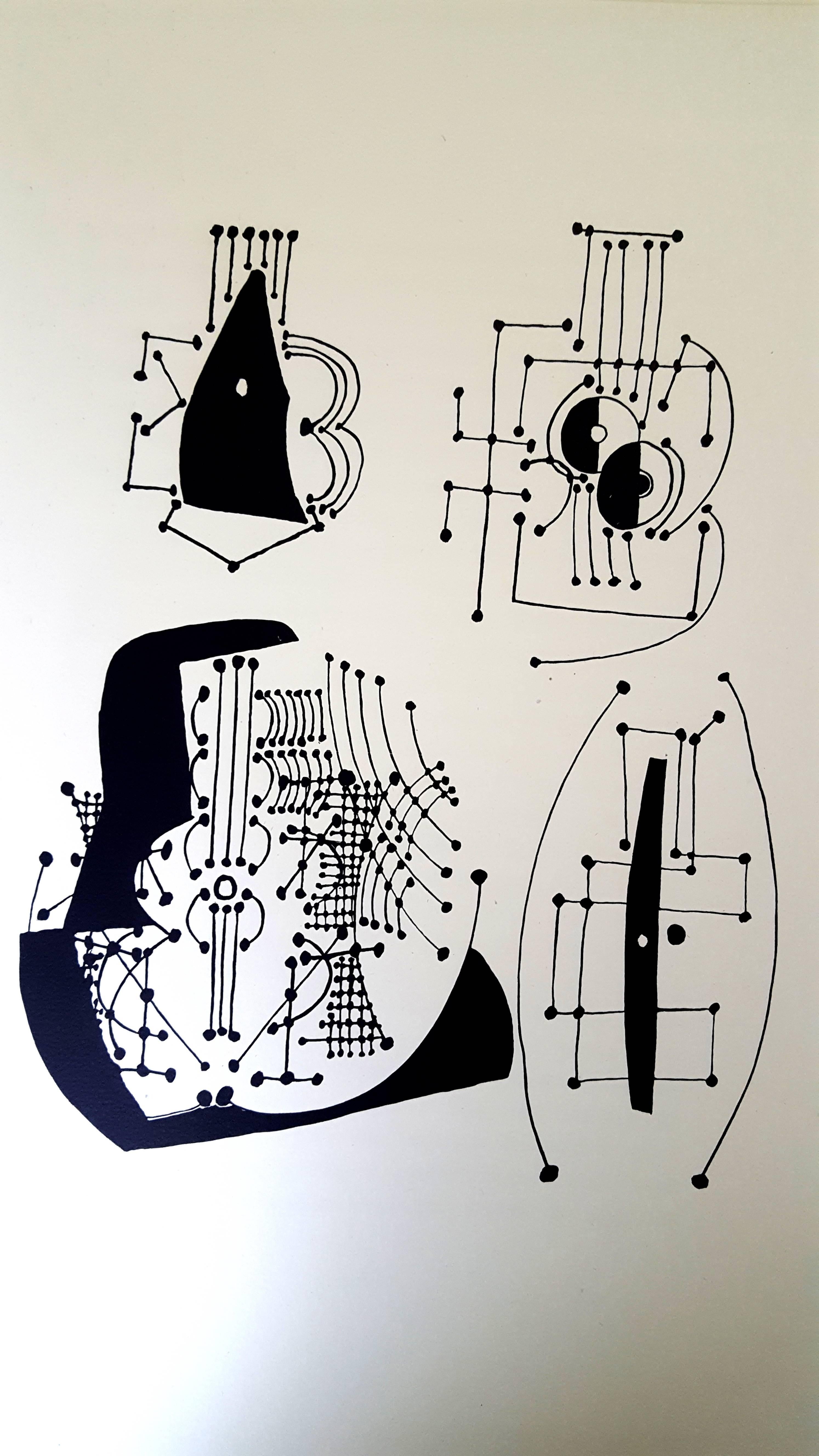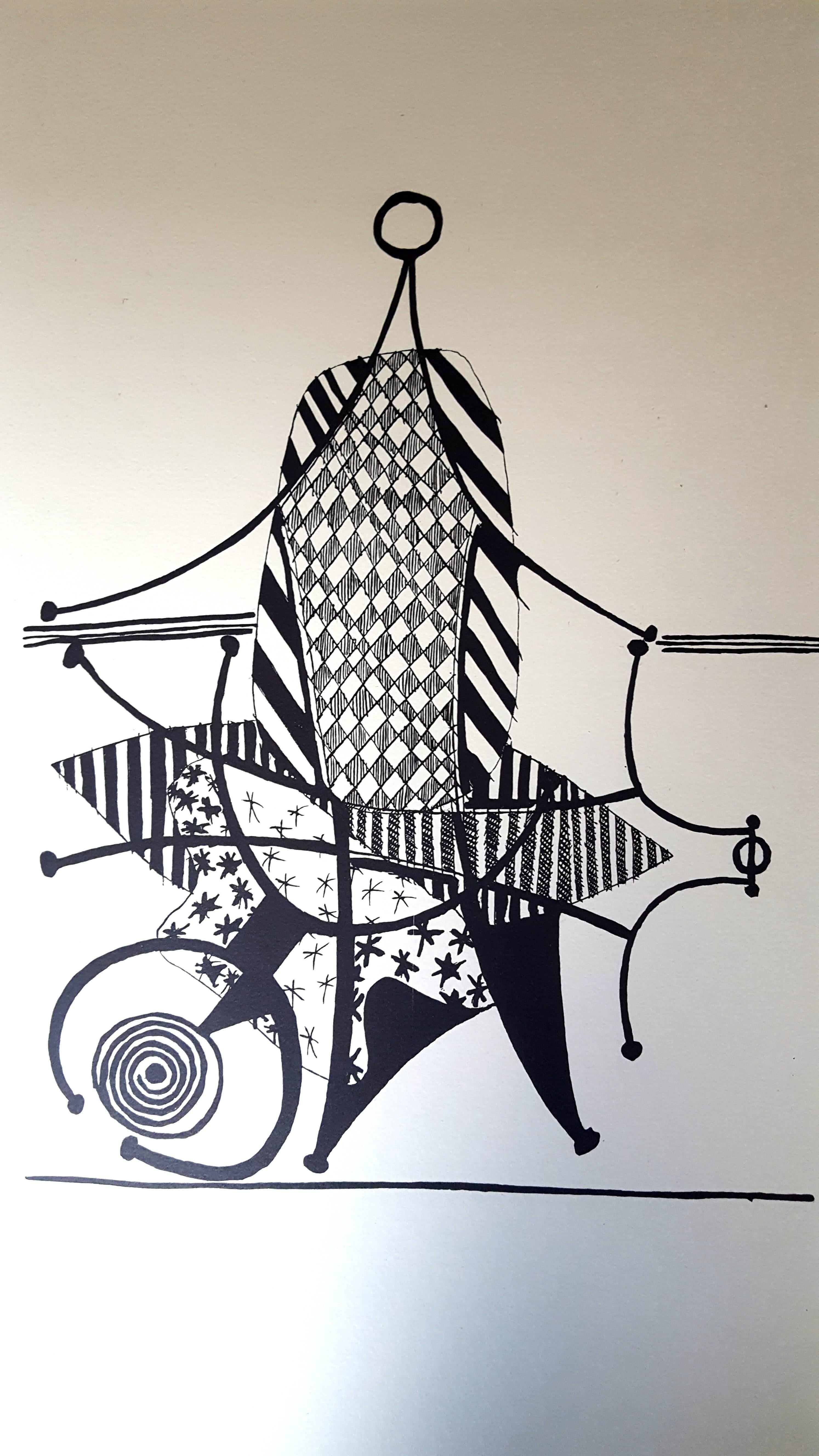Items Similar to 'Le Tir Forain' (Fairground Shooting) — 1920s French Cubism
Want more images or videos?
Request additional images or videos from the seller
1 of 4
Jean-Emile Laboureur'Le Tir Forain' (Fairground Shooting) — 1920s French Cubism1920-21
1920-21
About the Item
Le Tir Forain, engraving, edition 108, 1920-21, Sylvain Laboureur 191. Signed and numbered '19/85 ép' in pencil. Initialed 'L' and dated 1920 in the matrix, upper right. A superb, richly-inked impression, in warm black ink, on Arches cream wove paper. The full sheet with margins (1 1/4 to 1 5/8 inches); two professionally repaired tears in the bottom right sheet corner, well away from the image, otherwise in excellent condition. Printed by the artist. Matted to museum standards, unframed.
'Le Tir Forain' is one of Laboureur’s most acclaimed engravings. André Dunoyer de Segonzac, the artist’s esteemed pupil, considered it Laboureur’s masterpiece. An impression of this work is in the McNay Art Museum.
ABOUT THE ARTIST
Born in Nantes in the summer of 1877, Emile Laboureur was the son of a prosperous bourgeois family. He went to Paris in 1895 to study law but found himself more often drawn to study at the famed art school Académie Julian, although he never officially enrolled there. Upon his introduction to the distinguished wood engraver Auguste Lepère, he decided to take up the formal study of printmaking.
Lepère’s technical instruction in the craft of printmaking was essential for Laboureur’s artistic initiation but provided little in the way of stylistic inspiration. It was Toulouse-Lautrec, with whom Laboureur had become socially acquainted in 1896, who liberated his sense of humor and allowed him to recognize the potentialities for the visual expression of wit and irony. Laboureur assimilated his own orthodox wood engraving and etching techniques with the convivial, cosmopolitan subject matter of Lautrec’s color lithographs. Concurrently, his work took increasing cognizance of other contemporary innovations: the baleful hallucinations of Odilon Redon; the serpentine curves and wry social observations of Pierre Bonnard; and, most importantly, the incisive black and white compositions of Félix Vallotton, whose influence stayed with Laboureur’s graphic works for twenty years.
By 1899, Laboureur had fulfilled his compulsory service with the military, which he despised, and was able to pursue his love of art full-time. Laboureur traveled extensively to study, work, and learn all there was about the history of engraving. He developed a vast knowledge and connoisseurship during his trips to Italy, Germany, and throughout Europe.
Laboureur traveled to the United States in 1903—the country and its people appealed to him enormously. He was intrigued by the frenzy of the great industrial capitals, by the spectacle of skyscrapers, by the conspicuous consumption of the monied classes, and equally by the urban proletariat. Among the cities he visited were Albany, Boston, New York, Newark, Philadelphia, and Pittsburgh. Pittsburgh captured his imagination and he produced two successful series based on the city – 'Ten Etchings from Pittsburgh' (1905) and 'In The Pittsburgh Mills' (1906). He would lecture wherever he went, especially in New York, under the name Jean-Emile.
Having stayed in London for a period, he finally settled in France for good by 1910. By that time analytical cubism had burst upon the art scene. Laboureur’s style, however, remained essentially unchanged for the next several years while he was digesting this new genre. By 1913, he began to invent a cubist vernacular that was distinctly his own, one that would rival Picasso, Villon, and Braque but one which was distinctly decorative rather than analytical.
With the outbreak of World War I, Laboureur was again enlisted in the military. This disruption to his artistic life necessitated a change in mediums. No longer able to produce etchings due to the bulky paraphernalia required for acid baths, he began to engrave his plates (which he often salvaged from an ammunition depot) directly with a portable burin. In 1916, he produced thirty-one engravings, among which was a series of nine published as ‘Petites images de la guerre sur le front britannique’. Their subject matter eschews the horror of war to focus on the absurd and comic aspects of the tragedy which engulfed Europe.
After the war, Laboureur turned increasingly to book illustration. He bought a house on the Breton coast and transformed himself from a bachelor bon-viveur into a country family man with two sons. He worked steadily during the 1920s, but due to the worldwide depression of the 1930s, his output began to lessen until 1939 when he was struck down by a disease that left him paralyzed and unable to work. His last two prints remain unfinished. He died in 1943.
Edited from: Robert Allen, ‘Jean-Emile Laboureur: A Centenary Tribute,’ Alliance Française, New York, 1977.
- Creator:Jean-Emile Laboureur (1877-1943, French)
- Creation Year:1920-21
- Dimensions:Height: 10.5 in (26.67 cm)Width: 9.88 in (25.1 cm)
- Medium:
- Movement & Style:
- Period:
- Condition:
- Gallery Location:Myrtle Beach, SC
- Reference Number:
About the Seller
5.0
Recognized Seller
These prestigious sellers are industry leaders and represent the highest echelon for item quality and design.
Platinum Seller
These expertly vetted sellers are 1stDibs' most experienced sellers and are rated highest by our customers.
Established in 1995
1stDibs seller since 2016
255 sales on 1stDibs
Typical response time: 1 hour
Associations
International Fine Print Dealers Association
- ShippingRetrieving quote...Ships From: Myrtle Beach, SC
- Return PolicyA return for this item may be initiated within 7 days of delivery.
More From This SellerView All
- La Receveuse (Bill Collector) —French CubismBy Jean-Emile LaboureurLocated in Myrtle Beach, SCJean-Emile Laboureur, 'La Receveuse', engraving, 1919, edition 8, first state of two (artist's proof). Laboureur, Godefroy 190. Signed and numbered '3/8 ép' in pencil. Initialed and...Category
1910s Cubist Figurative Prints
MaterialsEngraving
- 'La Danse' (Dance) — French Cubist WoodcutBy Raoul DufyLocated in Myrtle Beach, SCRaoul Dufy, 'La Danse' (Dance), woodcut, 1910. A proof impression before the second edition of 220 in 1953; with the estate stamp 'ATELIER RAOUL DUFY' in the lower right margin; the blind stamp 'GG' in the lower left sheet corner. Annotated 'E/Z' in pencil, beneath the estate stamp; and 'bois original' in the margin, lower left. Titled in the block, lower right. A superb, richly-inked impression, on heavy, cream wove paper; the full sheet with wide margins (3 1/2 to 6 3/4 inches); slight toning at the bottom and right sheet edges, well away from the image, otherwise in excellent condition. Archivally sleeved, unmatted. Image size 12 5/16 x 12 1/2 inches (313 x 318 mm); sheet size 19 3/4 x 25 3/4 inches (502 x 654 mm). Collections: Art Gallery of New South Wales (Australia), Brooklyn Museum, Cleveland Art Museum, Fine Arts Museums of San Francisco, Minneapolis Institute of Art, Museum of Fine Arts, Boston, The Nelson-Atkins Museum of Art, Nasher Museum of Art (Duke University), Toledo Art Museum. From the suite of four woodcuts entitled 'Les Plaisirs de la Paix' (The Pleasures of Peace), published by Éditions de La Sirène, Paris in 1926. The other three works in the series are 'La Peche' (Fishing), 'La Chase' (The Hunt), and 'L'amore' (Love). See our other listings for 'La Peche' and 'L'amore'. Collections: Brooklyn Museum, Art Gallery of New South Wales, Cleveland Museum of Art, Dallas Museum of Art, Fine Arts Museums of San Francisco, Minneapolis Art...Category
1910s Cubist Figurative Prints
MaterialsWoodcut
- 'La Pêche' (Fishing) — French Cubist WoodcutBy Raoul DufyLocated in Myrtle Beach, SCRaoul Dufy, 'La Pêche' (Fishing), woodcut, 1910, from the second edition of 220 printed in 1953. With the estate stamp 'ATELIER RAOUL DUFY' in the lower left margin. Numbered '106/220' in pencil, lower right. Titled in the block, lower right. A superb, richly-inked impression, on heavy, cream wove paper, the full sheet with wide margins (3 to 5 inches), slight toning at the sheet edges, well away from the image; otherwise in excellent condition. Archivally sleeved, unmatted. Image size 12 1/2 x 15 13/16 inches (318 x 402 mm); sheet size 19 9/16 x 25 3/4 inches (497 x 654 mm). From the suite of four woodcuts entitled 'Les Plaisirs de la Paix' (The Pleasures of Peace), originally published by Éditions de La Sirène, Paris in 1926. The other three works in the series are 'La Danse' (The Dance), 'La Chase' (The Hunt), and 'L'amore' (Love). See our other listings for 'La Danse' and 'L'amore'. Collections: Cleveland Museum of Art, Minneapolis Art...Category
1910s Cubist Figurative Prints
MaterialsWoodcut
- 'On Stage' — Mid-Century Surrealism, Atelier 17Located in Myrtle Beach, SCIan Hugo, 'On Stage', from the portfolio 'Ten Engravings'. engraving, 1946, edition 50. Signed, dated, titled, and numbered '22/50' in pencil. A fine impression, with delicate overall plate tone, on cream wove paper, the full sheet with margins (3 5/8 to 4 7/8 inches), in excellent condition. With the blind stamp 'madeleine-claude jobrack EDITIONS', in the bottom right margin. Matted to museum standards, unframed. Image size 5 7/8 x 3 7/8 inches (149 x 98 mm); sheet size 15 1/8 x 11 1/8 inches (384 x 283 mm). Ian Hugo originally created "Ten Engravings" in 1945, and the portfolio included a foreword by his partner and collaborator, Anais Nin. In 1978, Hugo republished the portfolio with Madeleine-Claude Jobrack, an American master printmaker who studied under Stanley William Hayter at Atelier 17, Paris, and with Johnny Friedlaender. When Jobrack returned to the United States she managed the Robert Blackburn Printmaking Studio in New York before opening her own printing studio, Madeleine-Claude Jobrak Editions. “The sign of the true artist is one who creates a complete universe, invents new plants, new animals, new figures to transfer to us a new vision of the universe in which dream and reality fuse. Ian Hugo's plants have eyes, the birds have the delicacy of dragonflies, their feathers have the shape of fans. Humor is apparent in every gesture. He uses a fine spider web to give a feeling of flight, speed, lightness. The body of a woman reveals the structure of a leaf, a plant. Wings are moving in a world unified by mythological themes. This is an animated world, humorous and levitating, elusive and decorative, which by its unique forms and shapes gives us the sensation of a rebirth, a liberation from the usual, the familiar, a visit to a new planet.” —Anais Nin, from the forward to the portfolio ‘Ten Engravings’ ABOUT THE ARTIST Ian Hugo was born Hugh Parker Guiler in Boston, Massachusetts, on February 15, 1898. His childhood was spent in Puerto Rico—a "tropical paradise," the memory of which stayed with him and surfaced in both his engravings and his films. He attended school in Scotland and graduated from Columbia University where he studied economics and literature. Hugo was working with the National City Bank when he met and married author Anais Nin in 1923. The couple moved to Paris the following year, where Nin's diary and Guiler's artistic aspirations flowered. Guiler feared his business associates would not understand his interests in art and music, let alone those of his wife, so he began a second, creative life as Ian Hugo. Ian and Anais moved to New York in 1939. The following year he took up engraving and etching, working at Stanley William Hayter’s experimental printmaking workshop Atelier 17, established at the New School for Social Research. Hugo began producing surreal images often used to illustrate Nin's books. For Nin, his unwavering love and financial support were indispensable—Hugo was the "fixed center, core... my home, my refuge" (Sept. 16, 1937, Nearer the Moon, The Unexpurgated Diary of Anais Nin, 1937-!939). Fictionalized portraits of Higo and Nin appear in Philip Kaufman's 1990 film drama of a literary love triangle, Henry & June. Inspired by comments that viewers saw motion in his engravings, Hugo took up filmmaking. He asked the avant-garde filmmaker Sasha Hammid for instruction but was told, "Use the camera yourself, make your own mistakes, make your own style." Hugo embarked on an exploration of the film medium as a vehicle to delve into his dreams, his unconscious, and his memories. Without a specific plan, He would collect resonant images, then reorder or superimpose them, seeking a sense of self-connection through the poetic juxtapositions he created. These intuitive explorations resembled the mystical evocations of his engravings, which he described in 1946 as "hieroglyphs of a language in which our unconscious is trying to convey important, urgent messages." In the underwater world of his film ‘Bells of Atlantis,’ the light originates from the world above the surface; it is otherworldly, out of place, yet essential. In ‘Jazz of Lights,’ the street lights of Times Square become in Nin's words, "an ephemeral flow of sensations." This flow that she also calls "phantasmagorical" had a crucial impact on Stan Brakhage, who said that without Jazz of Lights (1954), "there would have been no Anticipation of the Night" his autobiographical film which ushered in a new era of experimental modernist filmmaking. Hugo lived the last two decades of his life in a New York apartment high above street level. In the evenings, surrounded by an electrically illuminated man...Category
1940s Surrealist Figurative Prints
MaterialsEngraving
- 'Early Marshes' — Mid-Century Surrealism, Atelier 17Located in Myrtle Beach, SCIan Hugo, 'Early Marshes', from the portfolio 'Ten Engravings'. engraving, 1943, edition 50. Signed, dated, titled, and numbered '37/50' in pencil. A fine impression, with delicate overall plate tone, on cream wove paper, the full sheet with margins (2 5/8 to 7 inches), in excellent condition. With the blind stamp 'madeleine-claude jobrack EDITIONS', in the bottom right margin. Matted to museum standards, unframed. Image size 5 x 5 7/8 inches (127 x 149 mm); sheet size 15 x 11 inches (381 x 279 mm). Ian Hugo originally created "Ten Engravings" in 1945 and the portfolio included a foreword by his partner and collaborator, Anais Nin. In 1978, Hugo republished the portfolio with Madeleine-Claude Jobrack, an American master printmaker who studied under Stanley William Hayter at Atelier 17, Paris, and with Johnny Friedlaender. When Jobrack returned to the States she managed the Robert Blackburn Printmaking Studio in New York before opening her own printing studio, Madeleine-Claude Jobrak Editions. “The sign of the true artist is one who creates a complete universe, invents new plants, new animals, new figures to transfer to us a new vision of the universe in which dream and reality fuse. Ian Hugo's plants have eyes, the birds have the delicacy of dragonflies, their feathers have the shape of fans. Humor is apparent in every gesture. He uses a fine spider web to give a feeling of flight, speed, lightness. The body of a woman reveals the structure of a leaf, a plant. Wings are moving in a world unified by mythological themes. This is an animated world, humorous and levitating, elusive and decorative, which by its unique forms and shapes gives us the sensation of a rebirth, a liberation from the usual, the familiar, a visit to a new planet.” —Anais Nin, from the forward to the portfolio ‘Ten Engravings’ ABOUT THE ARTIST Ian Hugo was born Hugh Parker Guiler in Boston, Massachusetts, on February 15, 1898. His childhood was spent in Puerto Rico—a "tropical paradise," the memory of which stayed with him and surfaced in both his engravings and his films. He attended school in Scotland and graduated from Columbia University where he studied economics and literature. Hugo was working with the National City Bank when he met and married author Anais Nin in 1923. The couple moved to Paris the following year, where Nin's diary and Guiler's artistic aspirations flowered. Guiler feared his business associates would not understand his interests in art and music, let alone those of his wife, so he began a second, creative life as Ian Hugo. Ian and Anais moved to New York in 1939. The following year he took up engraving and etching, working at Stanley William Hayter’s experimental printmaking workshop Atelier 17, established at the New School for Social Research. Hugo began producing surreal images often used to illustrate Nin's books. For Nin, his unwavering love and financial support were indispensable—Hugo was the "fixed center, core... my home, my refuge" (Sept. 16, 1937, Nearer the Moon, The Unexpurgated Diary of Anais Nin, 1937-!939). Fictionalized portraits of Higo and Nin appear in Philip Kaufman's 1990 film drama of a literary love triangle, Henry & June. Inspired by comments that viewers saw motion in his engravings, Hugo took up filmmaking. He asked the avant-garde filmmaker Sasha Hammid for instruction but was told, "Use the camera yourself, make your own mistakes, make your own style." Hugo embarked on an exploration of the film medium as a vehicle to delve into his dreams, his unconscious, and his memories. Without a specific plan, He would collect resonant images, then reorder or superimpose them, seeking a sense of self-connection through the poetic juxtapositions he created. These intuitive explorations resembled the mystical evocations of his engravings, which he described in 1946 as "hieroglyphs of a language in which our unconscious is trying to convey important, urgent messages." In the underwater world of his film ‘Bells of Atlantis,’ the light originates from the world above the surface; it is otherworldly, out of place, yet essential. In ‘Jazz of Lights,’ the street lights of Times Square become in Nin's words, "an ephemeral flow of sensations." This flow that she also calls "phantasmagorical" had a crucial impact on Stan Brakhage, who said that without Jazz of Lights (1954), "there would have been no Anticipation of the Night" his autobiographical film which ushered in a new era of experimental modernist filmmaking. Hugo lived the last two decades of his life in a New York apartment high above street level. In the evenings, surrounded by an electrically illuminated man...Category
1940s Surrealist Figurative Prints
MaterialsEngraving
- 'Together' — Mid-Century Surrealism, Atelier 17Located in Myrtle Beach, SCIan Hugo, 'Together', from the portfolio 'Ten Engravings'. engraving, 1946, edition 50. Signed, dated, titled, and numbered '22/50' in pencil. A fine impression, with delicate overall plate tone, on cream wove paper, the full sheet with wide margins (2 7/8 to 5 1/2 inches), in excellent condition. With the blind stamp 'madeleine-claude jobrack EDITIONS', in the bottom right margin. Matted to museum standards, unframed. Image size 5 7/8 x 4 7/8 inches (149 x 124 mm); sheet size 15 x 11 1/8 inches (381 x 283 mm). Collection: Indianapolis Museum of Art. Ian Hugo originally created "Ten Engravings" in 1945 and the portfolio included a foreword by his partner and collaborator, Anais Nin. In 1978, Hugo republished the portfolio with Madeleine-Claude Jobrack, an American master printmaker who studied under Stanley William Hayter at Atelier 17, Paris, and with Johnny Friedlaender. When Jobrack returned to the States she managed the Robert Blackburn Printmaking Studio in New York before opening her own printing studio, Madeleine-Claude Jobrak Editions. “The sign of the true artist is one who creates a complete universe, invents new plants, new animals, new figures to transfer to us a new vision of the universe in which dream and reality fuse. Ian Hugo's plants have eyes, the birds have the delicacy of dragonflies, their feathers have the shape of fans. Humor is apparent in every gesture. He uses a fine spider web to give a feeling of flight, speed, lightness. The body of a woman reveals the structure of a leaf, a plant. Wings are moving in a world unified by mythological themes. This is an animated world, humorous and levitating, elusive and decorative, which by its unique forms and shapes gives us the sensation of a rebirth, a liberation from the usual, the familiar, a visit to a new planet.” —Anais Nin, from the forward to the portfolio ‘Ten Engravings’ ABOUT THE ARTIST Ian Hugo was born Hugh Parker Guiler in Boston, Massachusetts, on February 15, 1898. His childhood was spent in Puerto Rico—a "tropical paradise," the memory of which stayed with him and surfaced in both his engravings and his films. He attended school in Scotland and graduated from Columbia University where he studied economics and literature. Hugo was working with the National City Bank when he met and married author Anais Nin in 1923. The couple moved to Paris the following year, where Nin's diary and Guiler's artistic aspirations flowered. Guiler feared his business associates would not understand his interests in art and music, let alone those of his wife, so he began a second, creative life as Ian Hugo. Ian and Anais moved to New York in 1939. The following year he took up engraving and etching, working at Stanley William Hayter’s experimental printmaking workshop Atelier 17, established at the New School for Social Research. Hugo began producing surreal images often used to illustrate Nin's books. For Nin, his unwavering love and financial support were indispensable—Hugo was the "fixed center, core... my home, my refuge" (Sept. 16, 1937, Nearer the Moon, The Unexpurgated Diary of Anais Nin, 1937-!939). Fictionalized portraits of Higo and Nin appear in Philip Kaufman's 1990 film drama of a literary love triangle, Henry & June. Inspired by comments that viewers saw motion in his engravings, Hugo took up filmmaking. He asked the avant-garde filmmaker Sasha Hammid for instruction but was told, "Use the camera yourself, make your own mistakes, make your own style." Hugo embarked on an exploration of the film medium as a vehicle to delve into his dreams, his unconscious, and his memories. Without a specific plan, He would collect resonant images, then reorder or superimpose them, seeking a sense of self-connection through the poetic juxtapositions he created. These intuitive explorations resembled the mystical evocations of his engravings, which he described in 1946 as "hieroglyphs of a language in which our unconscious is trying to convey important, urgent messages." In the underwater world of his film ‘Bells of Atlantis,’ the light originates from the world above the surface; it is otherworldly, out of place, yet essential. In ‘Jazz of Lights,’ the street lights of Times Square become in Nin's words, "an ephemeral flow of sensations." This flow that she also calls "phantasmagorical" had a crucial impact on Stan Brakhage, who said that without Jazz of Lights (1954), "there would have been no Anticipation of the Night" his autobiographical film which ushered in a new era of experimental modernist filmmaking. Hugo lived the last two decades of his life in a New York apartment high above street level. In the evenings, surrounded by an electrically illuminated man...Category
1940s Surrealist Figurative Prints
MaterialsEngraving
You May Also Like
- L'Éventail roseBy Marie LaurencinLocated in New York, NYA very good impression of this scarce color etching and drypoint. Fourth state (of 4). Signed and numbered 54/100 in pencil, lower margin.Category
1920s Cubist Abstract Prints
MaterialsColor, Drypoint, Etching
- Pablo Ruiz Picasso Spanish 1968 signed limited edition original art print n7By Pablo PicassoLocated in Miami, FLPablo Ruiz Picasso (Spain, 1881-1973) 'Visitante con nariz borbónica en casa de la Celestina', 1968 aquatint, sugarlift on oiled plate, dry point on paper 9.7 x 12.9 in. (24.6 x 32.6 cm.) Edition of 50 Conservation: The paper and the beards have been recently restored Unframed ID: PIC2001-007 Hand-signed by author The work is documented in the catalog raisonné Picasso Suite 347...Category
1960s Cubist Prints and Multiples
MaterialsAquatint, Drypoint, Etching
- Pablo Picasso (after) Helene Chez Archimede - Wood EngravingBy (after) Pablo PicassoLocated in Collonge Bellerive, Geneve, CHPablo Picasso (after) Helene Chez Archimede Medium: engraved on wood by Georges Aubert Dimensions: 44 x 33 cm Portfolio: Helen Chez Archimede Year: 1955 Edition: 240 (Here it is on...Category
1950s Cubist Figurative Prints
MaterialsEngraving, Woodcut
- Pablo Picasso (after) Helene Chez Archimede - Wood EngravingBy (after) Pablo PicassoLocated in Collonge Bellerive, Geneve, CHPablo Picasso (after) Helene Chez Archimede Medium: engraved on wood by Georges Aubert Dimensions: 44 x 33 cm Portfolio: Helen Chez Archimede Year: 1955 Edition: 240 (Here it is on...Category
1950s Cubist Figurative Prints
MaterialsEngraving, Woodcut
- Pablo Picasso (after) Helene Chez Archimede - Wood EngravingBy (after) Pablo PicassoLocated in Collonge Bellerive, Geneve, CHPablo Picasso (after) Helene Chez Archimede Medium: engraved on wood by Georges Aubert Dimensions: 44 x 33 cm Portfolio: Helen Chez Archimede Year: 1955 Edition: 240 (Here it is on...Category
1950s Cubist Figurative Prints
MaterialsEngraving
- Pablo Picasso (after) Helene Chez Archimede - Wood EngravingBy (after) Pablo PicassoLocated in Collonge Bellerive, Geneve, CHPablo Picasso (after) Helene Chez Archimede Medium: engraved on wood by Georges Aubert Dimensions: 44 x 33 cm Portfolio: Helen Chez Archimede Year: 1955 Edition: 240 (Here it is on...Category
1950s Cubist Figurative Prints
MaterialsEngraving
